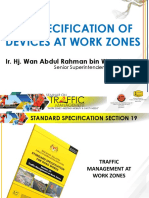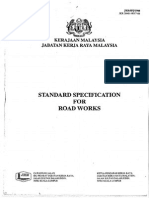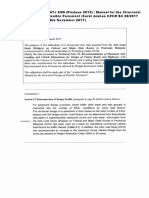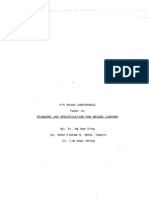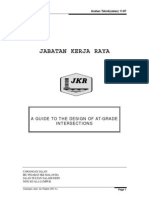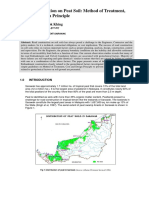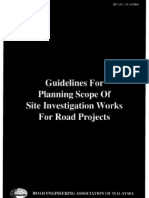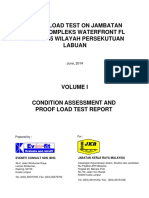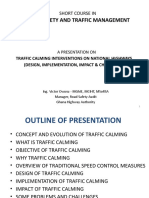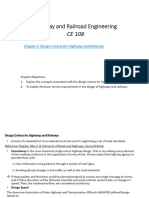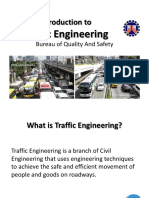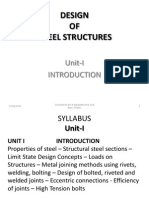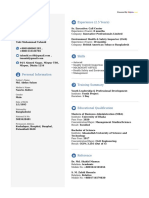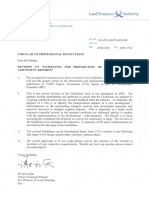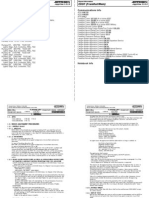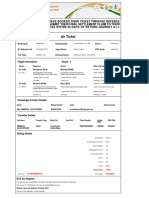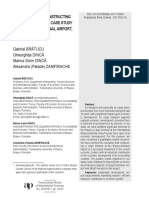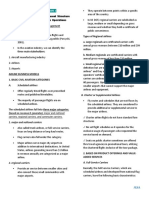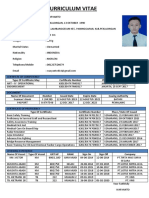Ream Tia
Ream Tia
Uploaded by
TahmidSaanidCopyright:
Available Formats
Ream Tia
Ream Tia
Uploaded by
TahmidSaanidOriginal Description:
Original Title
Copyright
Available Formats
Share this document
Did you find this document useful?
Is this content inappropriate?
Copyright:
Available Formats
Ream Tia
Ream Tia
Uploaded by
TahmidSaanidCopyright:
Available Formats
1 DAY WORKSHOP ON URBAN TRANSPORTATION IN PJ
- Engaging Local Community Participation for Sustainable Urban Transport Solutions
3 December 2013 at MBPJ Banquet Hall, Petaling Jaya
Jointly organized by the Institution of Engineers Malaysia and Majlis Bandaraya Petaling Jaya
Paper 1: Functionality of
Traffic Impact Assessment Study
REAM Guidelines for TIA
presented by:
Ir Chin Kar Keong
Chairman Highway & Transport Engineering Technical Division IEM &
Managing Director of Atur Trafik Sdn Bhd
Main Topics Covered
i) Traffic Impact Assessment as decision
making/planning tools,
ii) Use of traffic modeling/analytics
What is Traffic Engineering?
A branch of civil engineering that uses engineering techniques to achieve
the safe and efficient movement of people and goods on roadways. It
focuses mainly on research for safe and efficient traffic flow, such
as road geometry, sidewalks and crosswalks, segregated cycle
facilities, shared lane marking, traffic signs, road surface
markings and traffic lights.
Traffic engineering deals with the functional part of transportation system,
except the infrastructures provided. It is closely associated with other
disciplines:
Transport engineering
Pavement engineering
Bicycle transportation engineering
Highway engineering
Transportation planning
Urban planning
Human factors engineering.
Source: Wikipedia
Typical Role of Traffic Engineer
designs traffic control device installations and
modifications, including traffic signals, signs, and pavement
markings
considers traffic safety by investigating locations with high
crash rates and developing countermeasures to reduce
crashes
prepares short-term traffic flow management plans (e.g.
construction traffic control plans, including detour plans for
pedestrian and vehicular traffic)
prepares long-term traffic flow management plans
(estimating the impacts of proposed commercial
developments on traffic patterns)
develops systems for intelligent transportation systems
REAM GUIDELINES FOR TIA
Traffic Impact Assessment
decision making/planning tool
Why ?
When?
How?
What?
Criteria & Trigger Levels
No.
1
2
3
4
Criteria
Peak Hour Trip Generation
(commuter peak)
Off-peak Hour trip Generation
(Generation peak occurs at the
off-peak period)
Size of residential development
Size of commercial
development
Trigger Levels
150 added
veh/hr (2-way)
200 added
veh/hr (2-way)
200 dwelling
units
45,000 sq.ft
(gross floor area)
Note: Trip generation rates shall be based on Malaysian Trip generation Manual,
Highway Planning Unit, Ministry of Works, Malaysia
TIA Typical Contents (1/6)
i)
Executive Summary
Brief description of proposed development
Summary of traffic impact analysis
Brief description of proposed mitigation measures
ii)
Introduction
Description of proposed development
Traffic impact study methodology
iii) Defining the study area/boundary
Scope of study
Records of discussions and agreement with Developer and Approving
Authority
Description of road network within the agreed area of study
Map of road network in area of study
Typical Site Layout Plan
TIA Typical Contents (2/6)
iv) Determining existing traffic
Description of major traffic generators in and around the study area
Identification of developments with planning approval but not yet
implemented
Identification of committed transportation projects in the study area
Identification of designated links and intersections
Examination of historical data.
Volume survey of current traffic flows in designated links and
intersections within the study area
Survey of pedestrian flows at critical locations if necessary
TIA Typical Contents (3/6)
v)
Land Use study
Description of current planning policies of the Approving Authority for
the site of the proposed development including parking standards
Description of current usage of the site of proposed development
Description of land use of the proposed development, including site
area and development phasing
Breakdown of types and units of building in the proposed development
Site and layout plans
TIA Typical Contents (4/6)
vi) Trip Generation
Computation of trip generation (non-site traffic and site traffic)
Estimation of projected modal split
Estimation of trip generation for peak hours (with weekday and
development peak if necessary)
Justification of the values used
Computation of peak traffic volume, i.e. combination of generated and
network traffic
Specification of trip generation by phase (if appropriate)
Justification for methodology adopted for trip distribution and
assignment
Estimation of traffic growth rate over time for both Site and Non Site
traffic
TIA Typical Contents (5/6)
vii) Impact Analysis
Description of capacity analysis
technique
Tabulate and discuss traffic impact
analysis results
Proposed mitigation works and
determine the level of service with
improvement works scenario
Level of Service (LOS) based on HCM
A: free flow. Traffic flows at or above the posted
speed limit and motorists have complete
mobility between lanes. The average spacing
between vehicles is about 167m or 27 car
lengths. Motorists have a high level of physical
and psychological comfort. The effects of
incidents or point breakdowns are easily
absorbed. LOS A occurs late at night in urban
areas, frequently in rural areas, and generally in
car advertisements.
Level of Service (LOS)
B: reasonably free flow. LOS A speeds are
maintained, maneuverability within the traffic
stream is slightly restricted. The lowest
average vehicle spacing is about 100m or 16
car lengths. Motorists still have a high level of
physical and psychological comfort.
Level of Service (LOS)
C: stable flow, at or near free flow. Ability to maneuver
through lanes is noticeably restricted and lane changes
require more driver awareness. Minimum vehicle
spacing is about 67m or 11 car lengths. Most
experienced drivers are comfortable, roads remain
safely below but efficiently close to capacity, and posted
speed is maintained. Minor incidents may still have no
effect but localized service will have noticeable effects
and traffic delays will form behind the incident. This is
the target LOS for some urban and most rural highways.
Level of Service (LOS)
D: approaching unstable flow. Speeds slightly
decrease as traffic volume slightly increase. Freedom
to maneuver within the traffic stream is much more
limited and driver comfort levels decrease. Vehicles
are spaced about 50m or 8 car lengths. Minor
incidents are expected to create delays. Examples are
a busy shopping corridor in the middle of a weekday,
or a functional urban highway during commuting
hours. It is a common goal for urban streets during
peak hours, as attaining LOS C would require
prohibitive cost and societal impact in bypass roads
and lane additions.
Level of Service (LOS)
E: unstable flow, operating at capacity. Flow becomes
irregular and speed varies rapidly because there are
virtually no usable gaps to maneuver in the traffic
stream and speeds rarely reach the posted limit.
Vehicle spacing is about 6 car lengths, but speeds are
still at or above 80 km/h. Any disruption to traffic
flow, such as merging ramp traffic or lane changes,
will create a shock wave affecting traffic upstream.
Any incident will create serious delays. Drivers' level
of comfort become poor. This is a common standard
in larger urban areas, where some roadway
congestion is inevitable.
Level of Service (LOS)
F: forced or breakdown flow. Every vehicle
moves in lockstep with the vehicle in front of
it, with frequent slowing required. Travel time
cannot be predicted, with generally more
demand than capacity. A road in a constant
traffic jam is at this LOS, because LOS is an
average or typical service rather than a
constant state.
LOS at Junctions
TIA Typical Contents (6/6)
viii) Mitigation Measures
Description of proposed mitigation measures
Preliminary plans of mitigation measures
Justification (with appropriate computations) of how
negative impacts are mitigated
ix) Conclusions
Traffic Condition to be achieved:
Baseline Traffic Condition
in IAY (LOS)
A
B
C
D
E
F
Min Traffic Condition
(LOS) After Mitigation
Measures
D
D
D
D
D (exception E)
D (exception E)
USING TRAFFIC MODELLING TOOLS
Modelling a Regional Road Network
Strategy Urban Network Model
2D Micro Simulation (Network)
2D micro simulation (corridor)
Nano-simulation in Car Park
1 DAY WORKSHOP ON URBAN TRANSPORTATION IN PJ
- Engaging Local Community Participation for Sustainable Urban Transport Solutions
3 December 2013 at MBPJ Banquet Hall, Petaling Jaya
Jointly organized by the Institution of Engineers Malaysia and Majlis Bandaraya Petaling Jaya
Thank You
for listening
You might also like
- Basic Guidelines On Pedestrian FacilitiesDocument14 pagesBasic Guidelines On Pedestrian Facilitiesshafawiishak75% (4)
- Ream Tia GuideDocument30 pagesReam Tia GuideIr Kamarulzaman Abu Hassan88% (8)
- Slope Maintenance Management ManualDocument52 pagesSlope Maintenance Management ManualN.D.JijiNo ratings yet
- OCR ATJ 11 87 (PINDAAN 2017) - A Guide To The Design of At-Grade IntersectionsDocument168 pagesOCR ATJ 11 87 (PINDAAN 2017) - A Guide To The Design of At-Grade IntersectionsAbdul Rahman HilmiNo ratings yet
- D Internet Myiemorgmy Intranet Assets Doc Alldoc Document 13074 SPJ S11-LuarDocument41 pagesD Internet Myiemorgmy Intranet Assets Doc Alldoc Document 13074 SPJ S11-LuarMuhammad Hafizuddin100% (1)
- Traffic Impact AssessmentDocument6 pagesTraffic Impact AssessmentArah Louise Apostol50% (2)
- BOM SIN: TICKET - ConfirmedDocument3 pagesBOM SIN: TICKET - ConfirmedChandrashekhar ThiramdasuNo ratings yet
- REAM Guide Line PDFDocument120 pagesREAM Guide Line PDFmohd syafiq amirruddin ShariNo ratings yet
- REAM Guidelines On Geometric Design of RoadsDocument91 pagesREAM Guidelines On Geometric Design of RoadsHong Rui ChongNo ratings yet
- IWK Guide On FeeDocument1 pageIWK Guide On FeeJohnyReubenNo ratings yet
- Bpis Atj 8-86 19062020Document129 pagesBpis Atj 8-86 19062020Abdul Razef Abdul Rahim100% (1)
- Management of Road Safety by Public Works Department of MalaysiaDocument36 pagesManagement of Road Safety by Public Works Department of MalaysiaSyǝd Khairi100% (1)
- PAPER 4 TMWZ2018 The Specification of Devices at Work ZonesDocument62 pagesPAPER 4 TMWZ2018 The Specification of Devices at Work ZonesEiz Zu DeenNo ratings yet
- MS 544-Pt.5-2001 GCPDocument50 pagesMS 544-Pt.5-2001 GCPGan Chin PhangNo ratings yet
- Kuching - 18th Mile - Traffic StudiesDocument37 pagesKuching - 18th Mile - Traffic StudiesVincent Lau Hui ChekNo ratings yet
- D4 JKR SPJ 1988Document2 pagesD4 JKR SPJ 1988Muhammad100% (1)
- Chapter 3 - 9 (20212022-II) - ATJ 13-87pindaan2017 - 2edHODocument18 pagesChapter 3 - 9 (20212022-II) - ATJ 13-87pindaan2017 - 2edHONor Azwin BahariNo ratings yet
- Procedure For Road & Drainage Submission - 010515Document17 pagesProcedure For Road & Drainage Submission - 010515Kevin WongNo ratings yet
- Development of Design Guidelines For Rural Low Volume Roads in MalaysiaDocument12 pagesDevelopment of Design Guidelines For Rural Low Volume Roads in MalaysiagabemzamanNo ratings yet
- Guide On Geometric Design of RoadDocument113 pagesGuide On Geometric Design of RoadKha Mn100% (2)
- Addendum ATJ 5-85 (Pindaan 2013) - 2Document7 pagesAddendum ATJ 5-85 (Pindaan 2013) - 2Rozaini IsmailNo ratings yet
- Pavement Design 690mmDocument1 pagePavement Design 690mmAmier ThaqifNo ratings yet
- T1-07Rev.2014 13 Jan 2016 PDFDocument58 pagesT1-07Rev.2014 13 Jan 2016 PDFMohd Aizat DasimNo ratings yet
- Standard JKR Spec For Bridge LoadingDocument26 pagesStandard JKR Spec For Bridge Loadingholly329100% (1)
- Roundabout Design GuidelinesDocument76 pagesRoundabout Design GuidelinesDalibor StanicNo ratings yet
- Guide At-Grade IntersectionsDocument83 pagesGuide At-Grade IntersectionsZairi bin Zaini100% (3)
- JKR SIRIM PrePDFDocument4 pagesJKR SIRIM PrePDFkhairul AnwarNo ratings yet
- Arahan Teknik 8-86 R3Document1 pageArahan Teknik 8-86 R3Pipi KNo ratings yet
- Arahan Teknik Jalan JKRDocument3 pagesArahan Teknik Jalan JKRNabihah NasruddinNo ratings yet
- Paper 8 - Road Construction On Peat Soil May 2014 (Rev)Document16 pagesPaper 8 - Road Construction On Peat Soil May 2014 (Rev)Roziman Hj HajonNo ratings yet
- 7 JKR SPJ 2011-S7Document8 pages7 JKR SPJ 2011-S7Carwen WongNo ratings yet
- Hydrological & Hydraulic Report - Volume 1 (June 2004-Final) PDFDocument199 pagesHydrological & Hydraulic Report - Volume 1 (June 2004-Final) PDFChua Young Yau100% (3)
- Appendix 7 B Traffic Impact AssessmentDocument47 pagesAppendix 7 B Traffic Impact AssessmentLee TaiNo ratings yet
- BD 3394Document18 pagesBD 3394jrobert123321No ratings yet
- Rational Method Computation Time 30mins: Infravera SDN BHDDocument10 pagesRational Method Computation Time 30mins: Infravera SDN BHDazhar ahmadNo ratings yet
- JKR TOR BridgeDocument11 pagesJKR TOR BridgePawi Ishak50% (2)
- Dokumen - Tips - Ream Guidelines For Road Drainage Design Volume 4Document100 pagesDokumen - Tips - Ream Guidelines For Road Drainage Design Volume 4nasNo ratings yet
- Guidelines For Planning Scope of Site Investigation Works For Road Project REAM 6-2004Document25 pagesGuidelines For Planning Scope of Site Investigation Works For Road Project REAM 6-2004rowatersNo ratings yet
- Proof Load Test On Jambatan Jalan Kompleks Waterfront FL 745-000-45 Wilayah Persekutuan LabuanDocument82 pagesProof Load Test On Jambatan Jalan Kompleks Waterfront FL 745-000-45 Wilayah Persekutuan Labuanfarahazura100% (1)
- Projek Jalan Masuk Ke Empangan Bakun Negeri Sarawak - Progress Report No. 6 (February 1995) PDFDocument28 pagesProjek Jalan Masuk Ke Empangan Bakun Negeri Sarawak - Progress Report No. 6 (February 1995) PDFchung lawNo ratings yet
- REAM Crash Barriers PDFDocument97 pagesREAM Crash Barriers PDFmrasdanNo ratings yet
- Dokumen - Tips Arahan Teknik Jalan 6 85 Guidelines For Presentation of Engineering DrawingDocument29 pagesDokumen - Tips Arahan Teknik Jalan 6 85 Guidelines For Presentation of Engineering Drawingiris engineeringNo ratings yet
- Dokumen - Tips - Arahan Teknik Jalan 12 87 A Guide To The Design of Interchanges PDFDocument102 pagesDokumen - Tips - Arahan Teknik Jalan 12 87 A Guide To The Design of Interchanges PDFFendy RoynNo ratings yet
- A Guide To The Design of at Grade Intersections PDFDocument84 pagesA Guide To The Design of at Grade Intersections PDFLuis Artiaga Ben100% (3)
- Ream Guidelines On Geometric Design of Roads PDF FreeDocument91 pagesReam Guidelines On Geometric Design of Roads PDF FreeMervyn ChahNo ratings yet
- JKR-Arahan Teknik Road DesignDocument28 pagesJKR-Arahan Teknik Road DesignJeebers Crrebers100% (4)
- ATUR Trafik TIA 2018Document72 pagesATUR Trafik TIA 2018JK Bersatu VetroNo ratings yet
- Traffic Impact AssesmentDocument27 pagesTraffic Impact AssesmentJhonryll Natad GutierrezNo ratings yet
- Traffic (1)Document41 pagesTraffic (1)caballerogarry07No ratings yet
- Module 01 Introduction MergedDocument98 pagesModule 01 Introduction MergednjcapistranoxxxNo ratings yet
- Traffic Volume Study: DefinitionsDocument5 pagesTraffic Volume Study: DefinitionsMd TareqNo ratings yet
- Traffic EngineeringDocument64 pagesTraffic EngineeringAriz FaulineNo ratings yet
- traffic engineering unit 1Document10 pagestraffic engineering unit 1Suren MGNo ratings yet
- Traffic CalmingDocument65 pagesTraffic CalmingBernard OwusuNo ratings yet
- Notes On Chapters 3 and 4Document41 pagesNotes On Chapters 3 and 4ArKaDaTa21 ValienteNo ratings yet
- CIV3703 Transport Engineering (USQ)Document62 pagesCIV3703 Transport Engineering (USQ)hao baiNo ratings yet
- 1 - Introduction To Physical Design of Transportation FacilitiesDocument32 pages1 - Introduction To Physical Design of Transportation FacilitiesToqa AmjadNo ratings yet
- Introduction To: Traffic EngineeringDocument44 pagesIntroduction To: Traffic Engineeringangelo domanicoNo ratings yet
- CE 206 TE Module-3Document55 pagesCE 206 TE Module-3sangeethaah516No ratings yet
- Traffic Engineering - Concepts and TermininologyDocument2 pagesTraffic Engineering - Concepts and TermininologyjudaypacaldoNo ratings yet
- CAREC Road Safety Engineering Manual 2: Safer Road WorksFrom EverandCAREC Road Safety Engineering Manual 2: Safer Road WorksNo ratings yet
- Report 20 CVDocument3 pagesReport 20 CVTahmidSaanidNo ratings yet
- The Art of Inequality: Arquitecture, Housing and Real EstateDocument122 pagesThe Art of Inequality: Arquitecture, Housing and Real Estateaqdnk100% (1)
- Design of Steel Structures Presentation of LecturenotesDocument159 pagesDesign of Steel Structures Presentation of Lecturenotesshakirhamid6687No ratings yet
- LP Transcribed 13 4Document19 pagesLP Transcribed 13 4TahmidSaanidNo ratings yet
- Toki Mohammad TahmidDocument1 pageToki Mohammad TahmidTahmidSaanidNo ratings yet
- TheHikam HaeriTrust ZP SampleDocument52 pagesTheHikam HaeriTrust ZP SampleTahmidSaanidNo ratings yet
- TIA Guidelines Ireland PDFDocument21 pagesTIA Guidelines Ireland PDFTahmidSaanidNo ratings yet
- Easy TajweedDocument31 pagesEasy TajweedRobina Rehman100% (3)
- Review of ITE Recommended ParcticeDocument42 pagesReview of ITE Recommended ParcticeTahmidSaanidNo ratings yet
- TIA Guidelines York RegionDocument24 pagesTIA Guidelines York RegionTahmidSaanidNo ratings yet
- TIA Guidelines Ottawa PDFDocument36 pagesTIA Guidelines Ottawa PDFTahmidSaanidNo ratings yet
- TIA Guidelines SingaporeDocument24 pagesTIA Guidelines SingaporeTahmidSaanidNo ratings yet
- TIA Guidelines BahrainDocument44 pagesTIA Guidelines BahrainTahmidSaanidNo ratings yet
- TIA GuidelineDocument22 pagesTIA GuidelineuntoniNo ratings yet
- Tia NZDocument76 pagesTia NZTahmidSaanidNo ratings yet
- TIA AustraliaDocument18 pagesTIA AustraliaTahmidSaanidNo ratings yet
- TIA Guidelines TasmaniaDocument43 pagesTIA Guidelines TasmaniaTahmidSaanidNo ratings yet
- Traffic Report RAJUK Flyover DevConDocument161 pagesTraffic Report RAJUK Flyover DevConTahmidSaanidNo ratings yet
- Airport Authority Report For BbaDocument62 pagesAirport Authority Report For BbaJagan VmNo ratings yet
- Lowwefhk PDF 02jun21Document61 pagesLowwefhk PDF 02jun21Flight YearsNo ratings yet
- Platinum Driver Employment HistoryDocument1 pagePlatinum Driver Employment HistoryMarco Zavala OrnelasNo ratings yet
- EDDFDocument63 pagesEDDFEdin NukicaNo ratings yet
- Car Word Receipt 1Document21 pagesCar Word Receipt 1Khirod PatraNo ratings yet
- Nishu 3Document2 pagesNishu 3Dibya DillipNo ratings yet
- NDDOT 2019 Crash SummaryDocument24 pagesNDDOT 2019 Crash SummaryRob PortNo ratings yet
- Instruction Manual For Leyland DAF T244-4-Tonne 4x4 Lorry PDFDocument371 pagesInstruction Manual For Leyland DAF T244-4-Tonne 4x4 Lorry PDFhernanNo ratings yet
- AirportDocument19 pagesAirportPratikaha ShindeNo ratings yet
- 400scale b777-200ER AmericanDocument1 page400scale b777-200ER AmericanMohamed DhiaaNo ratings yet
- Trans Cargo Terminal - GiurgiulestiDocument16 pagesTrans Cargo Terminal - GiurgiulestiPanioglo SergiuNo ratings yet
- AE8302-Elements of Aeronautical Engineering: Reg. NoDocument2 pagesAE8302-Elements of Aeronautical Engineering: Reg. NoViswanath ViswaNo ratings yet
- Caterpillar Diesel LllengineDocument20 pagesCaterpillar Diesel LllengineRandi GunawanNo ratings yet
- Police Log October 7, 2016Document15 pagesPolice Log October 7, 2016MansfieldMAPoliceNo ratings yet
- BAOPNMAX CM Week1&2 ACT102Document17 pagesBAOPNMAX CM Week1&2 ACT102Bernadette Loise VelascoNo ratings yet
- Airline Business Reviewer Midterms 1Document5 pagesAirline Business Reviewer Midterms 1Gabriel MuliNo ratings yet
- M-346 Vs T-50 For PAF 18 May 2012Document22 pagesM-346 Vs T-50 For PAF 18 May 2012Mario FranciscoNo ratings yet
- Piper+Cherokee+Checklist 230515 160852Document11 pagesPiper+Cherokee+Checklist 230515 160852BraydenNo ratings yet
- 4.04 Generator Log Sheet Jan 2022Document3 pages4.04 Generator Log Sheet Jan 2022nagaaNo ratings yet
- CV Ant4 WaryantoDocument1 pageCV Ant4 WaryantoDwi NY OfficialNo ratings yet
- CTC22147232Document2 pagesCTC22147232Koushik RayNo ratings yet
- FQIDocument2 pagesFQIAman SharmaNo ratings yet
- Police Log August 30, 2016Document15 pagesPolice Log August 30, 2016MansfieldMAPoliceNo ratings yet
- Crafter Vans Jan2014Document40 pagesCrafter Vans Jan2014vladoteleaNo ratings yet
- Market Monitor Eu Jan To Mar23 Jun23Document7 pagesMarket Monitor Eu Jan To Mar23 Jun23The International Council on Clean TransportationNo ratings yet
- Flight Tutorial CLS A340 Series LFBO-LFMNDocument41 pagesFlight Tutorial CLS A340 Series LFBO-LFMNevilNo ratings yet
- Log TMBMC26Y123514233 175210km 108870miDocument3 pagesLog TMBMC26Y123514233 175210km 108870miRosu AlinNo ratings yet
- E.7 Unit 11: Travelling in The Future - No1Document3 pagesE.7 Unit 11: Travelling in The Future - No1Chi Đào KhánhNo ratings yet
- Revelator: ALTO 3300Document1 pageRevelator: ALTO 3300Galih Adi NugrohoNo ratings yet












